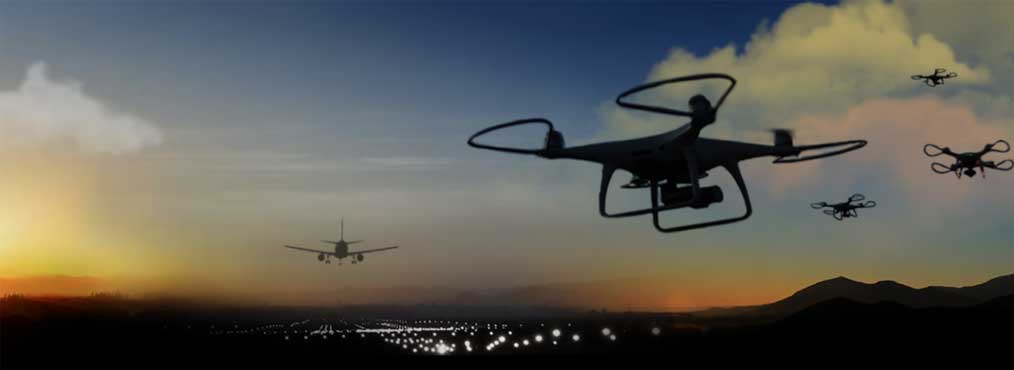
Harnessing the Power of Technology Integration to Solve Drone Challenges at Speed of Need
Delivering effective counter unmanned aerial systems (CUAS) depends on integrating best-of-breed technology in a system-of-systems approach that is tailorable to the specific needs of each customer
Key Takeaways:
- Unmanned aerial systems (UAS), or drones, are a growing security threat to both defense and private-sector organizations.
- The increasing sophistication of drones means that counter unmanned aerial systems (CUAS) must integrate a range of capabilities to thwart different types of threats.
- The system-of-systems integration approach to developing CUAS solutions, using open-architecture technologies from different manufacturers and a standards-based command-and-control structure, represents the most effective and efficient way to address drone threats.
LISTEN TO THIS BLOG:
Without question, unmanned aerial systems (UAS) have become one of the most pressing and complex threats facing militaries and law enforcement agencies around the globe. For the past 15 months, the world has watched Ukrainian and Russian forces attempt to leverage, and counter, UAS and technologies to gain advantage on the battlefield. This back and forth has wrought lessons on both sides, and Western nations are taking copious notes. Unmanned systems are deployed in the thousands per month on both sides with increasing scale almost weekly.
Stateside, the increase of commercial and recreational use of UAS has enabled a proliferation of highly capable drones occupying U.S. airspace, creating a new potential threat to federal, state and local authorities, in addition to private organizations like the sports franchises and concert venues. Examples include the temporary halting of a recent NFL game due to UAS over the playing field, disruption of air traffic at Washington D.C.'s Reagan National Airport, and numerous instances of trespassing and smuggling operations using drones.
To address dissimilar security environments and continuously evolving drone threats, it is important to have tailored counter unmanned aerial systems (CUAS) solutions for detecting, identifying, tracking and defeating them. The system-of-systems (SoS) approach is preferred, as it enables maximum mission effectiveness against multiple types of threats and considers the operator's skill set.
An enterprise approach to an emerging need
As a technology-agnostic systems integrator with over a decade of expertise in building, sustaining and supporting complex systems-of-systems, SAIC has designed, developed, tested and delivered a proven CUAS system capable of detecting, tracking, identifying and defeating UAS threats at home, abroad and in contingency locations. Our CUAS system incorporates best-in-class technology with an open-architecture, common command-and-control (C2) structure that enables SAIC to work with many different types of users across military and private-sector organizations.
Notably, our CUAS SoS construct is tailorable to the mission and environment, scalable to the nature of the threat, configured for the user, technology-agnostic to enable rapid and affordable upgrades that keep pace with evolving threats and simple to use.
Integrating, then fielding, individual systems developed by a multitude of manufacturers remains an intricate challenge. Many CUAS systems are stovepiped, personnel-intensive arrangements requiring multiple operators. At SAIC, our standards-based digital backbone not only differentiates our system, but it also enables a single operator to manage all the integrated capabilities. Additionally, our adaptable CUAS system is easily incorporated into existing programs of record and scales appropriately to protect multiple assets.
Further, our solution leverages emerging data analytics and artificial intelligence technology for machine learning to help the single user quickly and effectively evaluate targets, ingest all forms of available information from every connected sensor, analyze it, and provide real-time data — including patterns of life or threat — to the operator, along with a choice on courses of action.
Looking with pride in both directions at multiple locations
After more than two decades with SAIC, and eight months leading the team supporting the Army, I marvel at our team’s immense capability. I have been especially impressed with the Huntsville, Ala.-based CUAS program under the leadership of Greg Fortier and the exponential value the program provides across the business.
That value is rooted in the thousands of passionate mission-oriented innovators, who remain confident in our ability to provide the pre-eminent CUAS solution, as well as past successes, including being honored as the 2023 Gold Winner for Military Technology in the Edison Awards. SAIC has a proven CUAS track record that includes involvement in securing the 2012 Olympics, a New Year’s Eve celebration in New York City, a papal visit in 2015 and multiple G20 and G8 summits. More recently, our performance at three separate Army Joint Counter-small Unmanned Aircraft Systems Office (JCO) demonstrations over the past 18 months has exceeded all expectations.
I am most proud of our CUAS team's willingness to deliver high-performing capability through open competition, and as a large number of CUAS opportunities continue to evolve at SAIC, the potential to continue innovating is exciting.
The speed and value of a technology-agnostic systems integration approach
The past two decades of UAS advancement have shown an operating environment that will only become more complex and demanding. Providing an affordable, producible, reliable and agile CUAS SoS that successfully responds to the stresses of the ever-changing operating environment remains the ultimate objective.
Inevitable advances in UAS technology and complexity are easily addressed through any openly architected system-of-systems. SAIC’s configurable, tailorable and scalable CUAS system weathers the traditional acquisition headwind of obsolescence and evolves appropriately with strategies and doctrine.
An open-architecture approach enables customers, users and developers to quickly adapt and incorporate newer technologies, and the SoS approach enables supply chain variety, thereby creating redundancy and resilience. This is critical to not only delivering capabilities fast, but also ensuring they are usable in the field.




